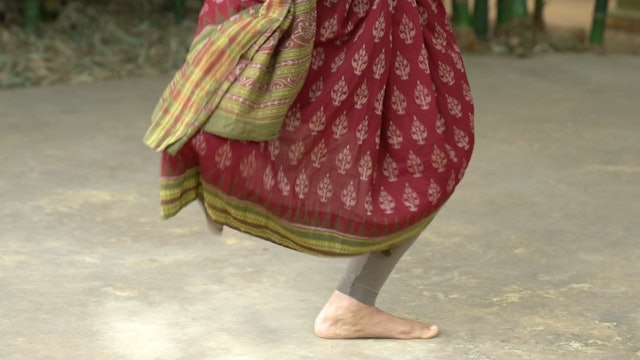-
Warm up : Isolations
The warm up changes in length and content as your body changes. What a conditioned body needs to warm up is very different than a body that is beginning this journey. This warm up is safe and helps a dancer at every level to find openness in the body. It can be done in combination with the hip op...
-
Sthanas/ Positions used in Adavus
Adavus have starting , transitory and ending positions. It is important to know, understand and embody these positions before embarking on Adavu practice. These positions are mentioned in the Natyashastra and Abhinaya Darpana with different names. The RK Method refers primarily to the Natyashastra.
-
Arm positions in adavus
The video explains muscle engagement and visualisation to make your arms work with finesse and clarity. The premise of the Raadha Kalpa method is that the movement of the limbs must arise from the core. This video explains the logic of muscular engagement such that the arms are not disconnected f...
-
Alignment in Adavus
The video describes the various Sthanas that are used in the practice of Adavus and the right alignment and muscle engagement to ensure longevity and safety in practice.
-
Thattadavu 1
The Thattadavu introduces concepts of rhythm to the beginner student through various patters of striking the floor with the foot. Do these in sequence to progressively build clarity in the articulation of the foot with the floor. Keep your hips stable and try not to move from side to side. It is ...
-
Thattadavu 2
The Thattadavu introduces concepts of rhythm to the beginner student through various patters of striking the floor with the foot. Do these in sequence to progressively build clarity in the articulation of the foot with the floor. Keep your hips stable and try not to move from side to side. It is ...
-
Thattadavu 3
The Thattadavu introduces concepts of rhythm to the beginner student through various patters of striking the floor with the foot. Do these in sequence to progressively build clarity in the articulation of the foot with the floor. Keep your hips stable and try not to move from side to side. It is ...
-
Thattaduvu 4
The Thattadavu introduces concepts of rhythm to the beginner student through various patters of striking the floor with the foot. Do these in sequence to progressively build clarity in the articulation of the foot with the floor. Keep your hips stable and try not to move from side to side. It is ...
-
General mobility
This is a great session to do on a day when you feel tight or sore. It opens up your body without expecting too much of it. You can also do it before you start a warm-up or after a strength or dance session. It is a session that is safe to practice early in the morning.
-
Introduction to Jathis and Korwais
You will learn the definition of a Jathi and Korwe and the contexts in which these rhythmic sequences are used in the traditional structure of choreography.
-
What does the Raadha Kalpa Method do for you?
A video that shows the kind of content one will have access to in the program.
-
Asamyukta Hasta
The Asamyuta hastas, as described in the Abhinaya Darpana are 28 in number.
These Hastas are used as embellishments in adavus as well as to communicate meaning gesturally, The Viniyogas in the Abhinaya Darpana describe a number of possible gestural implications for each Hasta.
Please refer to...
-
Samyukta Hasta
The Asamyuta hastas, as described in the Abhinaya Darpana are 28 in number.
These Hastas are used primarily communicate meaning gesturally, The Viniyogas in the Abhinaya Darpana describe a number of possible gestural implications for each Hasta.
Please refer to the Shloka below for pronunciat...














